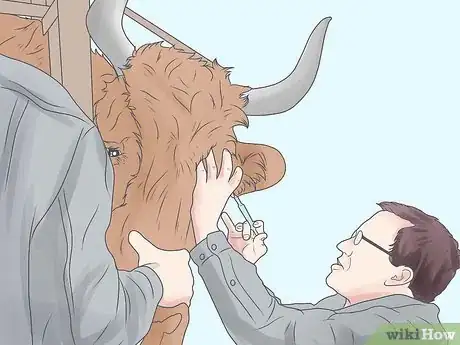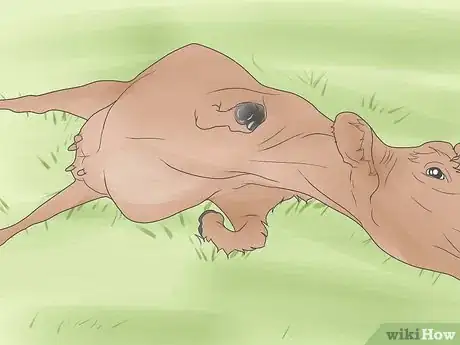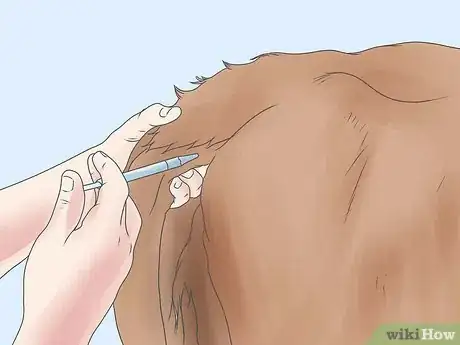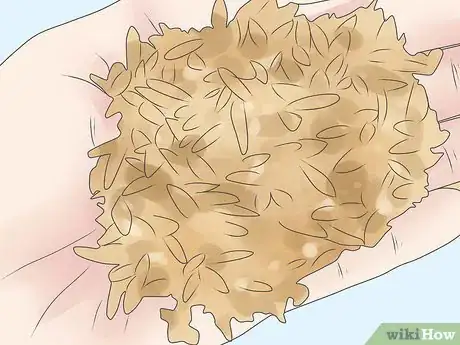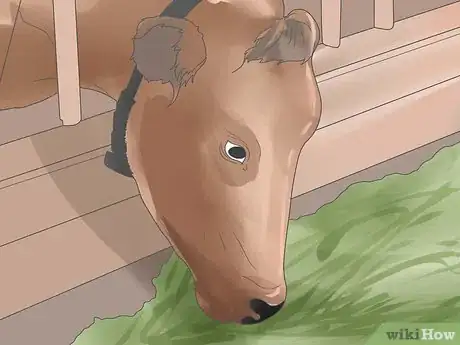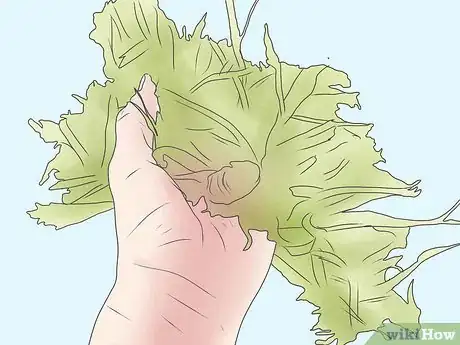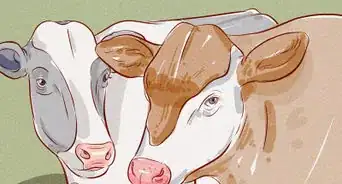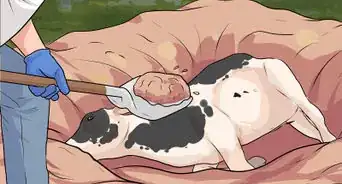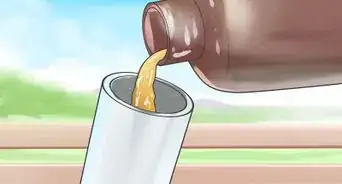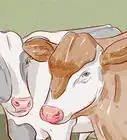wikiHow is a “wiki,” similar to Wikipedia, which means that many of our articles are co-written by multiple authors. To create this article, 12 people, some anonymous, worked to edit and improve it over time.
wikiHow marks an article as reader-approved once it receives enough positive feedback. In this case, 96% of readers who voted found the article helpful, earning it our reader-approved status.
This article has been viewed 161,252 times.
Learn more...
Acidosis is a metabolic disorder of the rumen (one of the four chambers of a ruminant's stomach [ruminants include animals like cattle and sheep]) where pH levels decrease very rapidly as a result of a sudden switch in diets from roughage (like hay and grass) to high-concentrates (like grain). Acidity below a pH of 5 to 6 supports lactic-acid producing bacteria, and consequently, as lactic acid builds up in the rumen, it can cause even more acid to be produced. Acidosis never occurs in cattle that are on a primary-forage-based diet, but it does more often in feedlot cattle, feed-tested bulls and heifers, and in dairy cows.
There are two types of acidosis: acute and sub-acute. Acute acidosis is the more serious condition, as it hits both hard and very quickly, but less frequently for the animal. Sub-acute acidosis is less intense, but more frequent, and can be chronic for an animal, particularly one that is in the feedlot. Both are covered in the steps below.
Steps
Acute Acidosis
-
1Know the symptoms of Acute Acidosis as described below.
-
Symptoms: Cattle with acute acidosis may go into shock and die suddenly due to a result of overwhelming increase in acidity in the rumen.[1]
- Those that do not die quickly are listless and often lethargic, and wander aimlessly around the pen, or just simply don't get up from lying down. They also often appear weak and anorexic and dehydrated.
- Related health problems may occur from an animal having acute acidosis. Rumen lining may be damaged from the sudden drop in acidity leaving the lining of the stomach to be damaged, causing rumenitis, or an infection of the rumen wall. Inflammation also occurs in the abomasum and intestinal walls, often destroy the villi that are responsible for nutrient absorption from the digesta.
- Poor feed efficiency, slow growth, poor weight gain or a drop in milk production is often a result of this inflammatory damage.
- Occasionally acidosis is responsible for a suppressed immune system which may prevent an animal's ability to ward off infection from airborne or communicable viruses or bacteria.
- Founder (also called Laminitis) and bloat are also a result of this metabolic disorder.
- Founder often leaves cattle permanently lame. This is a serious case for young bulls that are being feed-tested prior to sale, more so than in dairy cows or feedlot steers/heifers.
- Bloat is a serious disorder that disables a bovine to release any gases that have built up in the rumen. The rumen can engorge so much that it crushes the lungs and eventually asphyxiates cattle if not treated immediately.
- Liver abscesses are also common in cattle that had acidosis. Reduced feed intake, feed efficiency, weight gain and carcass yield is often a result of abscesses in the liver.
- Liver abscesses often cannot be seen until the animal is slaughtered. Abscessed livers are condemned at slaughter, because they are not deemed safe for humans to eat.
- Polioencephalomalacia (not related to the paralyzing human version of polio) is also a concern for cattle that have had acidosis.
-
Symptoms: Cattle with acute acidosis may go into shock and die suddenly due to a result of overwhelming increase in acidity in the rumen.[1]
-
2Treat the cattle that are suspected to have acidosis, if you can before they up and die on you.
- Thiamine is often a highly recommended injection to give to cattle with acute acidosis, as it is very important in treating and stopping a sudden acidosis attack.[2]
Acidosis very often halts the production of thiamine through digestion,[3]
and an injection of Thiamine will reverse this process.
- Baking soda will also work as a treatment for cattle with acidosis.[4]
Advertisement - Thiamine is often a highly recommended injection to give to cattle with acute acidosis, as it is very important in treating and stopping a sudden acidosis attack.[2]
Acidosis very often halts the production of thiamine through digestion,[3]
and an injection of Thiamine will reverse this process.
-
3It is best to visit your vet as soon as possible to get a proper dosage and any other necessary additional treatments needed.
Subacute Acidosis
-
1Symptoms include kicking at the belly due to ingestion, as well as discomfort, drooling, panting, eating dirt, and diarrhea.
- Diarrhea can often be a foamy greyish colour, especially in those animals where it is more serious.
-
2Most animals recover from subacute acidosis without treatment, but to be safer than sorrier, have treatments on hand
Prevention of Acidosis
-
1The most obvious preventative measure is to not have cattle on grain in the first place. This is because grain is not a natural diet for cattle, and often causes more issues and illnesses than grass or hay does. This is often one faultless preventative measure that a lot of producers can (and do) fall back on.
-
2Feeding grain often cannot be avoided, though, so gradually increasing the grain ration over time is the best way to prevent acidosis while still feeding cattle grain.
-
3Always include roughage with the grain diet you are giving your cattle. This helps with ease of digestion in the rumen, and also prevents the microbes in the rumen from digesting this high-concentrate ration too fast.[5]
- Roughage should not be finely chopped, as this will often defeat the purpose of preventing acidosis. Coarsely-chopped (or not chopped at all!) roughage is best.
-
4Often Nature-caused interruptions like storms, hot- or cold-spells, and extreme weather, or change in schedules such as being handled or hauled to a new farm or ranch can cause cattle to reduce their feed intake or stop eating all together until the danger has passed. Then they over-eat to compensate for the loss of diet they missed during this interruption. Often during extremely hot spells cattle won't eat during the day, then eat their hearts out at night when it's cooler.
- Thus, try to keep feeding schedules as routine as possible and keep feeding to several times a day to keep cattle from getting hungry between meals.
Community Q&A
-
QuestionGold Coast. Looks like one of my Galloway cow (550kg) has, Laminitis. Has been limping for one week now. Cows are in a paddock but grass is growing slowly now (grass mix of rye, millet, kikuyu, carpet grass. I give each cow an additional 1/4 biscuit of barley hay. Could that cause acidosis?
 Community AnswerHave your cow checked out by a veterinarian to determine whether it actually is laminitis or something else like foot-rot, a corm in the hoof, a leg injury, etc. The barley "hay" (is this greenfeed or straw?) will not cause acidosis. What will cause acidosis is an excess of high-energy feed like grain, as mentioned in the article above. The fibre in the greenfeed will prevent acidosis from occurring because it is in high fibre.
Community AnswerHave your cow checked out by a veterinarian to determine whether it actually is laminitis or something else like foot-rot, a corm in the hoof, a leg injury, etc. The barley "hay" (is this greenfeed or straw?) will not cause acidosis. What will cause acidosis is an excess of high-energy feed like grain, as mentioned in the article above. The fibre in the greenfeed will prevent acidosis from occurring because it is in high fibre. -
QuestionHow much baking soda should I use?
 Community Answer500 grams (17.5 oz) sodium bicarbonate (baking soda) is recommended.
Community Answer500 grams (17.5 oz) sodium bicarbonate (baking soda) is recommended. -
QuestionHow do I save a cow if the liver of cow is dead?
 KarinTop AnswererThere is no hope to save her. Euthanasia is the kindest and only option you have to put her out of her misery.
KarinTop AnswererThere is no hope to save her. Euthanasia is the kindest and only option you have to put her out of her misery.
Warnings
- Always be careful when feeding grain to cattle, especially if you want to increase weight gains or milk production at a faster pace than you could with forage.⧼thumbs_response⧽
- Avoid feeding grain to cattle if they don't need it, or if it's really not necessary, like with brood cows or cattle where all your doing is trying to maintain weight, not increase it.⧼thumbs_response⧽
- As mentioned above, acidosis can suppress the immune system, and any kind of foreign body like bacteria or virus can easily kill an animal that had acute acidosis.⧼thumbs_response⧽
- Sometimes you may be too late to save an animal, and will get a dead animal instead of live one. Expect that with any kind of livestock you raise.⧼thumbs_response⧽
References
- ↑ http://www.thecattlesite.com/diseaseinfo/193/rumen-acidosis/
- ↑ http://www.iowabeefcenter.org/bch/Acidosis.pdf
- ↑ https://www.ncbi.nlm.nih.gov/pmc/articles/PMC2957033/
- ↑ https://www.ecofarmingdaily.com/raise-healthy-livestock/cattle/treating-rumen-acidosis-in-cattle%EF%BB%BF/
- ↑ https://www.ecofarmingdaily.com/raise-healthy-livestock/cattle/treating-rumen-acidosis-in-cattle%EF%BB%BF/
- Thomas, H.S. The Cattle Health Handbook: Preventative Care, Disease Treatments & Emergency Procedures for Promoting the Well-Being of Your Beef or Dairy Herd. Chapter 8: Digestive Problems. USA: Storey Publishing. 2009. pp. 165-166.
- http://www.thebeefsite.com/articles/1926/beef-cattle-nutritional-disorders

